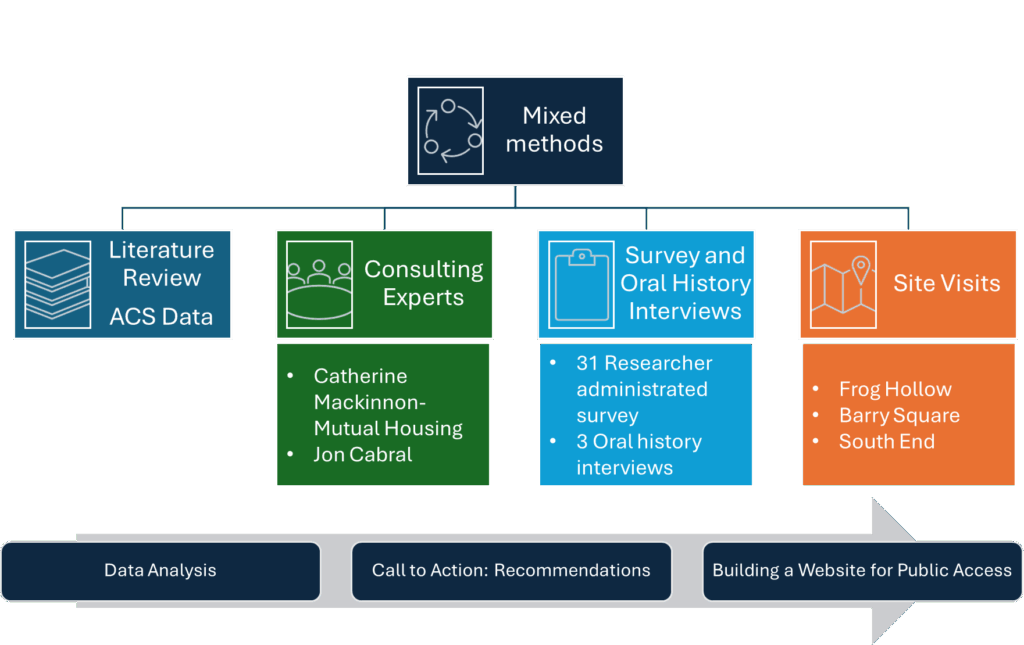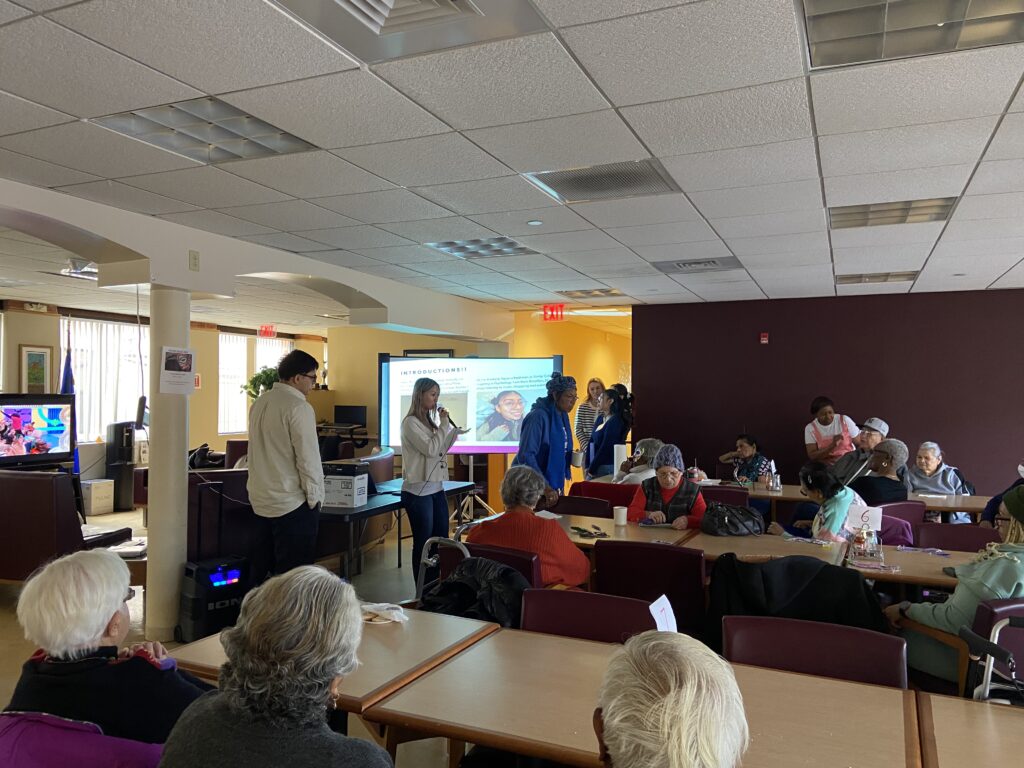
Data Collection
Why Surveys and Oral Histories
Survey Protocol
Oral History Interviews
Data Analysis
Secondary Data Collection and Analysis
Assess Local Potential-Vacant Properties
Limitations
Our Research Methodology: From Problem to Policy
We used a mixed-methods, community-engaged research approach guided by four interconnected steps:
Data Collection
Our primary data collection methods were surveys and oral history interviews. This combination allowed us to gather both structured quantitative data and deeper personal stories to understand the lived experiences of seniors in Hartford.
Building Trust and Rapport with Participants: Event Planning and Outreach
To develop rapport with our participants for the surveys and oral history interviews, we organized a presentation day at the senior center. During this event, we conducted our surveys and engaged in informal interviews and chats with the seniors. This allowed us to build relationships and establish trust for the oral history interview outreach. To promote the event, we also prepared flyers. We were supported in this effort by our community partner, Hyacinth Ywette, and the senior center director, Awilda Rodriguez.

Our team visited the South End Wellness Senior Center, building relationships and listening to seniors’ experiences to help shape our affordable housing project together.
View our flyers in both English and Spanish here.
Why Surveys and Oral Histories?
Surveys are a foundational method in social science research because they allow researchers to collect consistent, quantifiable data from a broad population within a limited time frame. This makes them particularly useful for accessing participants efficiently and identifying large-scale trends and correlations-such as the relationship between race, income, and access to housing (Creswell & Creswell, 2018). In our project on affordable senior housing in Hartford, surveys enabled us to reach a diverse group of older adults and assess their housing needs, perceptions of affordability, and neighborhood preferences.
Oral histories, by contrast, offer rich, narrative-based insights into participants’ lived experiences. They help us understand the emotional, relational, and historical dimensions of housing insecurity and aging in place-elements often lost in numerical data alone (Shopes, 2011). In the context of participatory action research, oral histories also reflect a justice-centered approach that values the voices and agency of community members, especially those who are often excluded from traditional decision-making processes (Kindon, Pain, & Kesby, 2007). By combining both methods, our project not only documents patterns in housing need but also amplifies personal stories that can drive more responsive, community-centered housing solutions in Hartford.
Survey Protocol
We designed a bilingual (English and Spanish) survey covering seven core areas:
- Demographics
- Current housing situation
- Housing challenges and experiences
- Experiences of Those Who Moved
- Perspectives on community and social connection
- Future housing preferences
- Policy & Community Solutions
31 seniors participated in the survey. Key demographic highlights:
- Age: 52% were between 75–84 years old
- Race/Ethnicity: 42% Black, 35% Hispanic or Latine
- Gender: 87% female, 13% male
Surveys were conducted primarily at the South End Wellness Senior Center, a community gathering place for seniors in the area.
View our full survey protocol here (English) and here (Spanish).
Oral History Interviews
To complement the surveys, we conducted three in-depth oral history interviews:
Sue: A 72-year-old who moved to Hartford from Alabama at age 18. She described repeated issues with landlords, safety concerns due to break-ins, and her long journey toward stable housing.
Eugenia: A Spanish-speaking senior who lived in Hartford and later moved to Manchester. She emphasized the role of family and multigenerational support in her housing journey.
M: A long-time South End resident since the 1990s, M. shared her struggle with inaccessible housing that makes day-to-day life challenging. Although she owned her home and did not face affordability issues, she highlighted the difficulties she encountered due to the inaccessibility of her housing.
Interviews were conducted in English and Spanish. You can view our oral history protocol here (English) and here (Spanish).
Data Analysis
Our analysis followed a mixed-methods approach:
- Surveys were researcher-administered on paper at the South End Wellness Senior Center, ensuring accessibility for all participants. The research team transcribed the completed surveys into a digital format using Excel, where we organized, cleaned, and analyzed the data. We examined trends in demographics, housing needs, and preferences, focusing on relationships between variables such as income, race/ethnicity, and housing accessibility.
- Interview data was transcribed and coded for recurring themes using. Key themes such as housing instability, intergenerational living, accessibility issues, and neighborhood attachment emerged through this process. These themes were used to contextualize and deepen our understanding of the survey findings. We included direct quotes from interviews to provide personal context and highlight individual perspectives.
Secondary Data Collection and Analysis
In addition to primary data, we analyzed secondary data sources to contextualize our findings:
- National Housing Preservation Database (NHPD): Helped us identify affordable housing units in Hartford.
- Connecticut Housing Finance Authority (CHFA): Provided data on existing senior housing developments, including funding, and demographics of households (income status and race).
- American Community Survey (ACS): Offered neighborhood-level data on age, income, race/ethnicity, disability status, and housing burden.
These data sources helped us:
- Map the supply and demand mismatch for affordable senior housing.
- Understand demographic trends impacting seniors, such as rent burdens.
Secondary data was synthesized to validate our findings and highlight policy implications grounded in broader housing and demographic patterns. Using tools like Social Explorer, Google Maps and GIS mapping, we visualized spatial patterns to guide our field visits and vacant property assessments.
Assess Local Potential-Vacant Properties
To understand opportunities for local development, we conducted a site-based evaluation of housing possibilities:
- Field Survey of Properties: Our team visited and assessed vacant and underutilized properties in the Frog Hollow, Barry Square, and South End neighborhoods.
- Evaluation Criteria: We considered factors such as walkability, proximity to senior services (like clinics and community centers), and the development feasibility of each site.
- Zoning and Conditions Review: We reviewed Hartford’s zoning regulations, building codes, and neighborhood conditions to determine what kinds of development are allowed or encouraged in each area.
This site analysis was crucial for connecting community need with real, developable land/property-ensuring that our recommendations are grounded in on-the-ground feasibility.
Limitations
Sample size was modest: 31 surveys and 3 oral histories, meaning findings are not statistically generalizable but are meaningful for local insights. Initially, we planned focus group discussions; however, due to time constraints and scheduling conflicts with both our team and the seniors at the center, we switched to surveys. To overcome this limitation, we also conducted oral history interviews.
Timeline: A semester-limited project meant limited time for follow-up or deeper outreach.
Self-reporting bias may affect how participants described their housing and health challenges.
Still, this data provides a valuable foundation for community-informed advocacy and further research.